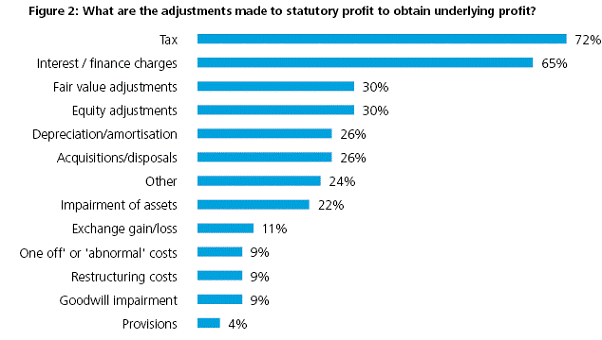Non-Statutory Profits Assignment Help
AYB200 Financial accounting – semester 1, 2011
Queensland University of Technology
Non- Statutory Profits- Practice and Implications
(Name of the student)
Executive Summary
This is a report prepared for the Sydney office of an International firm of public accountants. The report discusses the reporting of non statutory measures such as underlying profits. In the last few years, especially after global financial crisis, the rise in the reporting of underlying profits can forced analyst to ask for mandatory reporting of underlying profits. The following report discusses underlying profit reporting practices, their proliferation and implications of such practices. To retrieve the data for the report the websites of big four accounting firms have been accessed, for e.g. Deloitte, Ernst and Young, KPMG and PWC. The sites of AICD and Finsia are also visited so as to know the current development of this practice. (2) The finding indicated that the corporations have started reporting on underlying profits on their own self with the intention to provide users with better information to assess the financial performance of the company. (3) It is recommended that though corporations have voluntarily started reporting on non statutory measures, at the same time there should be transparency and consistency. (4) There are no visible limitations in adopting this practice because nothing technical is there, there are just 7 principles which are to be followed and a reconciliation statement with consistent adjustment factors are the desirable reporting requirements.
Background on Statutory and non Statutory Profits:
Statutory profits are normalized profits of an organization disclosed as per the requirements of the IFRS and Corporation Act of Australia, Non- statutory accounts are the profit and loss and balance sheet accounts that relate to or purport to deal with the financial year of the company or its subsidiary undertaking in any form (MORRIS, G., MCKAY, S. & OATES, A., 2007, pg.151).
It has been observed during the past years that the number of corporations reporting on non statutory profits have increased manifold. According to a survey (KPMG, FY 2010) 2800 European financial statements were found to have disclosed non statutory performance measures to enable investors to better assess the performance of the company. But even this increase in the practice of reporting on non statutory profits is not helping analysts, shareholders and investors in evaluating the company correctly because of the inconsistency and lack of transparency while reporting non statutory profits. Firstly, the term underlying profit is used interchangeably by different corporations for example, some use terms such as EBITDA, EBITDAF, EBITA, distributable profit, net earnings/profit before abnormal/ unusual items while other companies use different terms in different years. Secondly, the adjustments shown in the statutory profits to reach at non statutory profits are also used inconsistently by the companies, for example if in one year, foreign exchange transaction impact is shown as adjustments the other year it is not shown. This inconsistently have been overcome by AICD and Finsia by jointly a document titled ‘Underlying Profit – Principles for reporting of non-statutory profit information’ to increase consistency in the reporting of the underlying profits; encourage transparency, good governance, positive economic behavior and comparable reporting. (AICD, FINSIA, 2009)
Current Reporting Practice of Underlying Profits
According to a report by KPMG for 100 companies in year 2009-10 financial years, most of the companies reported on underlying profits but in different forms and terms, according to the report the total number of reporting on underlying profits was 63% which was lower than 73% reporting in 2009. (KPMG, 2010)
Corporation are using different terms for underlying profits such as EBITDA, EBITDAF, EBITA, distributable profit, net earnings/profit before abnormal/ unusual items, the companies are not using the consistent adjustments year by year, also some companies are using different terms from one year to another. Thus a mass inconsistency and lack of transparency is seen in the current prevalent practices on underlying profits. (DELOITTE, 2010)-(appendix 1). The common adjustments are made by corporations over the past 3 years are:
Non-Statutory Profits Assignment Help By Online Tutoring and Guided Sessions from AssignmentHelp.Net
- Fair value of financial instruments
- Impairment of assets
- Income tax
- Restructuring costs
- Mergers, integration and divestments.
(DELOITTE, 2010)
Another point which needs consideration is that companies are using underlying profits for window dressing and cherry picking techniques. They widow dress the items before presenting them as adjustment to statutory profits and emphasize only items they wish to do. The companies disclosed underlying profits at various places and gave numerous references to them in the annual report.
Underlying Profits-Principles (AICD and Finsia, 2009)
As laid down in the guidance paper by AICD and FINSIA if corporation adhere to the seven principles of underlying profits, they can present their financial statements in a much coherent, transparent and consistent manner but this is possible only when the adoption of these principles have become mandatory by the regulations.
Principle1: non statutory profits and statutory profits should be reported together. The companies should clearly differentiate between the two profit figures in a consistent manner.
Principle2: the only term ‘underlying profit’ should be used to report non statutory profits; no other term should be used.
Principle 3: a reconciliation statement should be presented in the financial statements in a tabular form showing clearly the effect of each adjustment. The adjustments selected should be in line with the nature of business and the objective should be to provide a transparent, logical and justifiable reconciliation between both the profit figures
Principle 4: all the result of the reconciliation should be explained in the director’s report and management discussion and analysis.
Principle 5: all the adjustments with a negative or positive impact should be shown by corporations in their reconciliation statements.
Principle 6: this principle is on consistency, it says that adjustments shown in one reporting period should be same with the other reporting period.
Principle7: corporation needs to separately disclose in their financial statements about the adherence to these underlying profit principles.

Implications
The correct and proper use of underlying profits is considered important from the perspective of shareholders and valuation analysts, who use these figures to evaluate the future value of the company and in various valuation models, (MACKAY, R., 2009). But the incorrect and misleading presentations of underlying profits by the corporations from year to year makes difficult for the investors to understand the financial statements and future prospects of the company. (MEDIA RELEASE, 2009).
The AICD fears that non statutory profits may be used by companies to take the attention of investors away from the statutory profits and influence the understandability of financial statements. As a result the document issued by the AICD and Finsia can serve investors and users of financial statements to detect good governance and positive outlook of the companies and invest their money intelligently.
Appendix1:
References
- Rob Mackay, 2009, “Reporting of non-statutory profit figures-Underlying Profits, retrieved from: http://moorestephensresources.com.au/articles/276/1/Reporting-of-non-statutory-profit-figures--Underlying-Profits/Page1.html
- KPMG, Underlying Profits Report, FY 10, retrieved from: http://www.kpmg.com/AU/en/IssuesAndInsights/ArticlesPublications/Documents/Underlying-profits-report-FY10.pdf
- KPMG, Underlying Profits Report, FY 10, key findings, retrieved from: http://www.kpmg.com/AU/en/IssuesAndInsights/ArticlesPublications/Pages/Underlying-profits-report-FY10.aspx
- ASIC, 2010, “10-147MR ASIC focuses attention on 2010 financial reports”, retrieved from: http://www.asic.gov.au/asic/asic.nsf/byheadline/10-147MR+ASIC+focuses+attention+on+2010+financial+reports?openDocument
- ASX release, 2009, ANZ 2009 Interim Result, retrieved from: http://phx.corporate-ir.net/External.File?item=UGFyZW50SUQ9MjE2NDY0MXxDaGlsZElEPTM0MjMzNHxUeXBlPTI=&t=1
- Deloitte, use of Underlying profit leaps post GFC, retrieved from: http://www.deloitte.com/assets/Dcom-Australia/Local%20Assets/Documents/news-research/Press%20releases/Use_of_underlying_profit_leaps_post_GFC.pdf
- Underlying Profit, retrieved from: www.companydirectors.com.au/.../FINAL_ FinsiaAICD%20%20Underlying%20Profits%20discussion%20paper.ashx
- Ernst and Young, “Proposed ASIC Guidance on Alternative Profit Disclosures”, retrieved from: www.ey.com/...profit.../Proposed_ASIC_guidance_on_alternative_profit_ disclosures.pdf
- Claytonutz, 2011, “Will ASIC outlaw “underlying profit”? retrieved from: http://www.claytonutz.com/publications/news/201103/29/will_asic_outlaw_underlying_profit.page
- PWC, Underlying profits, retrieved from: www.companydirectors.com.au/.../FINAL_ FinsiaAICD%20%20Underlying%20Profits%20discussion%20paper.ashx
- MACKAY, R., 2009. “Reporting of non-statutory profit figures – Underlying Profits” [online]. Available athttp://moorestephensresources.com.au/articles/276/1/Reporting-of-non-statutory-profit-figures--Underlying-Profits/Page1.html [Accessed 13 April 2011]
- MEDIA RELEASE, 2009. “New Profit Reporting Principles’, by Finsia and AICD, Media Release 10 March 2009.
- MORRIS, G., MCKAY, S. & OATES, A. 2007. “Finance Director's Handbook”. UK: Elsevier Ltd.
- SMITH, R., 2010. “Underlying profit: devil is in the detail”. The Sydney Morning Herald, Ferbruary 25, 2010.
- STRAGALINOS, P., 2009. “New Movement on Business Reporting/Corporate Communication - Australian experience from the implementation of IFRS”, Research Institute of Economy, Trade & Industry ., IAA. [online]. Available at http://www.rieti.go.jp/en/events/bbl/10031701.html[Accessed 19 April 2011]
- STUART, D., 2010. “Financial yearend reporting headaches”, Company Director Magazine, May 01, 2010.
- TAYLOR, S., 2011. “Revealing the gaps in non-GAAP reporting”. [online]. Available athttp://www.business21c.com.au/2011/04/revealing-the-gaps-in-non-gaap-reporting[Accessed 19 April 2011]
- DELOITTE, 2010. “Reporting Underlying Profits”. Deloitte Financial Reporting Survey Series, Issue 3, June 2010. [online]. Available at http://www.deloitte.com/assets/Dcom-NewZealand/Local%20Assets/Documents/Financial%20Reporting%20Survey/nz_en_FinancialReportingSurvey_Seriesissue3_062010.pdf [Accessed 19 April 2011]




